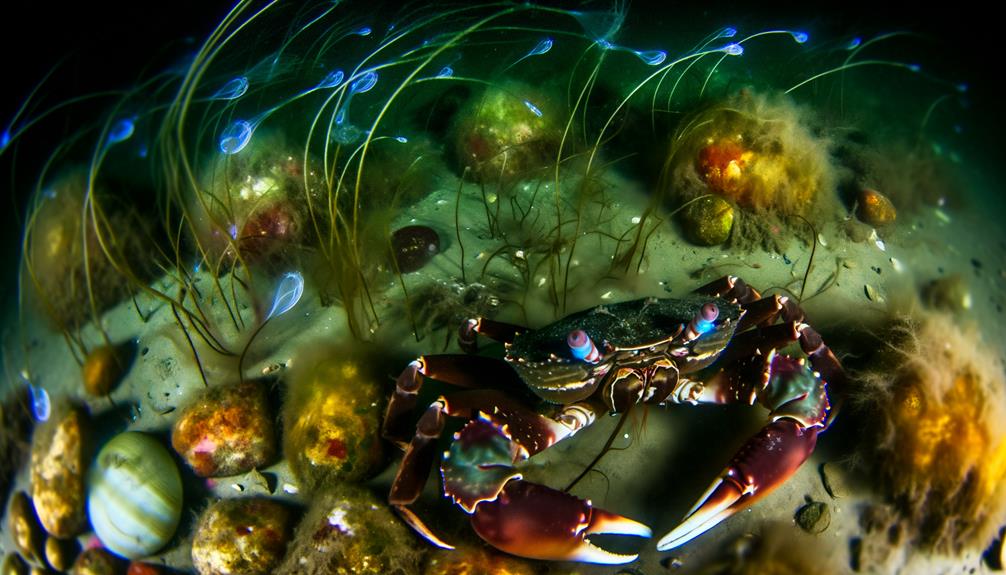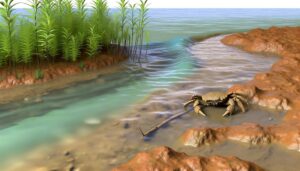Why Do Mud Crabs Not Live in Illinois?
Yes, mud crabs have hearts. You'll find their heart in the cephalothorax, a single-chambered, muscular organ essential for circulating hemolymph.
Hemolymph is their blood equivalent, circulating through an open circulatory system. The heart pumps hemolymph through arteries, eventually bathing organs directly in a spacious cavity known as the hemocoel.
This process ensures efficient nutrient delivery and waste removal. Valves inside the heart maintain a unidirectional hemolymph flow, preventing backflow.
Mud crabs' hearts, despite being small, are crucial to their survival, aiding in oxygen transport and homeostasis. Exploring further reveals more about their fascinating physiological adaptations.

Key Takeaways
- Mud crabs possess a heart located in the cephalothorax.
- The heart is a small, muscular organ with a single chamber.
- Hemolymph is circulated through the open circulatory system by the heart.
- Ostia in the heart allow hemolymph to enter for circulation.
- The heart ensures the delivery of nutrients and oxygen to organs.
Anatomy of Mud Crabs
In examining the anatomy of mud crabs, you'll find they possess a segmented exoskeleton that provides structural support and protection. This exoskeleton is composed primarily of chitin, a long-chain polymer that forms a tough, flexible shell.
The body is divided into two main regions: the cephalothorax and the abdomen. The cephalothorax houses essential organs and is covered by a large carapace, while the abdomen is tucked under the body, containing the reproductive organs.
Appendages include chelipeds (claws) for defense and feeding, and walking legs adapted for mobility in various substrates. Sensory organs, such as compound eyes and antennae, are crucial for navigation and environmental interaction.
This detailed anatomical structure enables mud crabs to thrive in their habitats.
Circulatory System Basics
Mud crabs possess an open circulatory system where hemolymph, rather than blood, bathes the organs directly in the hemocoel. You'll notice that hemolymph, which is the equivalent of blood in these crustaceans, isn't confined to vessels. Instead, it flows freely within the body cavity, enveloping tissues and organs.
This system relies on the hemolymph's movement to transport nutrients, waste products, and gases to and from cells. Unlike closed circulatory systems, the open system in mud crabs allows hemolymph to make direct contact with tissues, facilitating efficient exchange processes.
This arrangement is well-suited for their aquatic environments, enabling them to survive and thrive despite variations in oxygen availability and metabolic demands.
Heart Structure
Nestled within the cephalothorax, the heart of a mud crab is a small, muscular organ responsible for pumping hemolymph throughout its open circulatory system. This heart is composed of a single chamber, which is a characteristic feature of many crustaceans. You'll find that it's enclosed by a pericardial sinus and connected to several arteries.
To understand the heart structure better, consider these key components:
- Chamber: The heart has a single chamber that pumps hemolymph.
- Ostia: These are small openings allowing hemolymph to enter the heart from the pericardial sinus.
- Arteries: Several arteries extend from the heart to various parts of the body.
- Valves: These ensure unidirectional flow of hemolymph into and out of the heart.
This structure is crucial for the crab's survival.
How the Heart Works
You can start by understanding the circulatory system of mud crabs. This system includes a heart that pumps hemolymph through their open circulatory system.
The heart's structure consists of a single muscular chamber that functions by contracting rhythmically to maintain hemolymph flow.
Observations show that hemolymph moves from the heart into arteries, distributing nutrients and oxygen efficiently throughout the crab's body.
Circulatory System Overview
In the intricate circulatory system of mud crabs, the heart plays an essential role by actively pumping hemolymph through a network of arteries, ensuring important nutrients and oxygen reach all tissues.
This hemolymph, comparable to blood in vertebrates, circulates within an open system, bathing organs directly.
You'll notice that the hemolymph flow is crucial for:
- Nutrient Distribution: Hemolymph transports essential nutrients absorbed from the digestive tract.
- Oxygen Transport: Hemocyanin, a copper-based molecule, carries oxygen efficiently.
- Waste Removal: Metabolic wastes are carried to excretory organs for elimination.
- Immune Response: Hemolymph contains cells that defend against pathogens.
These processes are fundamental for maintaining the crab's physiological balance and overall health.
Heart Structure Analysis
The core of a mud crab, a muscular and centralized organ, pumps hemolymph through a series of precisely regulated contractions. You'll find that this core is located dorsally in the thorax, encased by a pericardial sinus.
It's composed of striated muscle fibers, which facilitate rhythmic contractions. The core's walls are thick and sturdy, ensuring efficient hemolymph propulsion. Valves within the core prevent backflow, maintaining unidirectional flow.
The cardiac ganglion, a specialized cluster of neurons, regulates heartbeat by sending timed electrical impulses. This intricate structure enables the core to sustain the mud crab's metabolic needs.
Detailed studies reveal that the cardiac cycle's precision is essential for maintaining internal homeostasis and overall biological function.
Blood Flow Mechanism
A well-coordinated series of contractions propels hemolymph through the mud crab's open circulatory system, ensuring efficient nutrient and oxygen distribution. The heart, located dorsally, pumps hemolymph into arteries that branch throughout the body.
You'll observe this process involves several essential steps:
- Systole: The heart contracts, pushing hemolymph into the arteries.
- Diastole: The heart relaxes, allowing hemolymph to return from the body.
- Ostia Function: Valves called ostia open to let hemolymph enter the heart chambers during diastole.
- Hemocoel Circulation: Hemolymph flows through the hemocoel, bathing organs directly.
This system lacks capillaries, making the direct contact between hemolymph and tissues crucial for metabolic exchange. Understanding these mechanisms highlights the efficiency of the mud crab's open circulatory system.
Blood Flow Mechanism
Mud crabs possess an open circulatory system where hemolymph, their blood equivalent, is pumped from the heart into the hemocoel, bathing organs directly. You'll find that the heart, located dorsally, plays an essential role in this process. It contracts rhythmically, propelling hemolymph through arteries that branch into smaller vessels. These vessels open into the hemocoel, allowing hemolymph to permeate tissues.
As a result, organs receive nutrients and waste products are removed efficiently. Hemolymph eventually returns to the heart through ostia, small openings equipped with valves to prevent backflow. This mechanism guarantees continuous circulation, maintaining homeostasis. Detailed studies confirm this efficient, albeit less directed, flow system is an evolutionary adaptation suited to the mud crab's ecological niche.
Oxygen Transport
Understanding the blood flow mechanism, you can now appreciate how hemolymph not only transports nutrients but also plays an important role in oxygen transport within mud crabs.
Hemolymph, enriched with the respiratory pigment hemocyanin, binds oxygen molecules for efficient distribution. This process is crucial for their survival in varying aquatic environments.
Observations show:
- Hemocyanin Function: Hemocyanin binds oxygen in the gills, facilitating its transport to tissues.
- Circulatory Efficiency: The heart pumps hemolymph through arteries, ensuring oxygen reaches all cells.
- Metabolic Support: Oxygenated hemolymph supports cellular respiration, necessary for energy production.
- Response to Hypoxia: Mud crabs can adjust hemolymph flow to optimize oxygen delivery during low-oxygen conditions.
These mechanisms underscore the adaptability and resilience of mud crabs in their habitats.
Comparison to Other Crustaceans
When comparing mud crabs to other crustaceans, you'll notice significant differences in their circulatory systems and oxygen transport mechanisms. Mud crabs possess an open circulatory system, similar to other crustaceans, but their hemolymph composition and heart structure vary.
For instance, mud crabs have a more robust heart that efficiently pumps hemolymph, containing hemocyanin, to transport oxygen. Unlike shrimp, which may rely on gill surface area for oxygen uptake, mud crabs exhibit specialized branchial chambers that enhance respiration.
Additionally, mud crabs' circulatory efficiency is augmented by their hemocyanin's higher affinity for oxygen compared to other crustaceans. This allows them to thrive in low-oxygen environments, showcasing their unique physiological adaptations within the crustacean family.
Evolutionary Adaptations
Examining these physiological traits, you can see how mud crabs' evolutionary adaptations have enabled them to excel in diverse and often challenging environments. These adaptations include:
- Osmoregulation: Mud crabs possess specialized gills that allow them to maintain internal homeostasis in fluctuating salinities.
- Exoskeleton Structure: Their hard, calcified exoskeleton provides robust protection against predators and environmental hazards.
- Burrowing Behavior: They exhibit burrowing behaviors, which help them avoid extreme temperatures and desiccation during low tides.
- Feeding Mechanisms: Mud crabs have evolved powerful claws for efficient foraging and crushing of hard-shelled prey.
These traits highlight mud crabs' remarkable ability to adapt and thrive in estuarine and coastal habitats, showcasing evolutionary ingenuity.
Importance of the Heart
The heart of mud crabs plays a key role in circulating hemolymph, delivering essential nutrients and oxygen to tissues while removing metabolic waste. This organ is essential in maintaining homeostasis and supporting the crab's metabolic activities.
Hemolymph, equivalent to blood in vertebrates, transports crucial substances through an open circulatory system. Without efficient heart function, tissues would experience hypoxia and nutrient deficiencies, impairing survival.
Scientific studies have shown that the heart's rhythmic contractions guarantee steady hemolymph flow, evidenced by observed heart rates correlating with activity levels. Detailed observations reveal that environmental stressors like temperature shifts can impact cardiac performance, highlighting the heart's adaptability.
Understanding this physiological mechanism underscores its importance in the overall health and functionality of mud crabs.
Conclusion
You've journeyed through the intricate world of mud crabs, unearthing details about their fascinating hearts. These little powerhouses pump life through the crab's body, ensuring oxygen reaches every nook and cranny.
Their unique circulatory system isn't just a mere quirk but a finely-tuned marvel of evolution. Compared to other crustaceans, mud crabs exhibit specific adaptations, showcasing nature's finesse.
So next time you see a mud crab, remember the tiny heart working tirelessly within.






